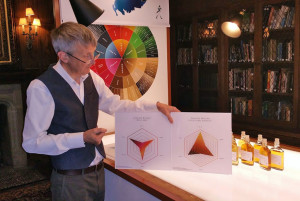Q&A With Dr. Jim Beveridge, Johnnie Walker Master Blender
By Kurt Maitland

(Credit: Kurt Maitland)
As the Master Blender for Diageo’s Johnnie Walker, Dr. Jim Beveridge has access to one of the most extensive collections of single malt and grain whiskies on the planet. His creations run from recent Johnnie Walker releases like the Explorers’ Club Collection and his re-imagining of an old classic, Johnnie Walker Double Black, to individual blends that run more than $130,000 a case.
And that is just for starters. With such a portfolio, Dr. Beveridge could easily sit on his laurels, but he is still pushing forward, looking at new grains, different woods, and of course, different blends via a quieter version of Buffalo Trace’s Warehouse X project. I had the pleasure of catching up with him during his first visit to NYC at the famed Explorers’ Club and talking about blends, single malts, and the world of whisk(e)y.
KM: I’ve read that when working on a new blend, you have a flavor profile in your head. Do you have certain whiskies in Diageo’s vast portfolio that you find yourself going to again and again?
JB: I think it depends. The answer to that is yes but which whiskies depends on the kind of blend I’m trying to make. I’m usually lucky in that I have massive choices. That gives me the ability to make a great diversity of styles of whisky. I think to be realistic, if you looked at diversity of flavors and styles, Diageo is pretty unique. Johnnie Walker is pretty unique. We have a huge diversity of options there.
KM: Are there any whiskies (single malt or grain) in the portfolio that you feel may be underappreciated by the public at large?
JB: It’s an interesting question because I think what lies behind the question is that actually our consumers are becoming more knowledgeable and so there is a real sense of what whiskies are out there. I think there are some whiskies that are more commonly talked about than others. Just because you aren’t talked about doesn’t mean to say you aren’t worth talking about.
KM: Right, so like how we discussed about Clynelish, a whisky that never gets as much attention as something like Talisker or Oban but I’m fond of it.
JB: There are distilleries like Mannochmore and Linkwood. There is a huge row of honor and within the blending community they are all well respected but perhaps are not so well known by the average consumer. I think there are some amazing whiskies in there.
KM: Congratulations on your induction into Whisky Magazine’s Hall of Fame. You’ve created the Explorers’ Club Collection, JW Platinum, JW Double Black among other additions to the JW range. Is there any one that was your favorite to create?
JB: Thank you! They are all really good. The ones that really stand out to me because of the diversity of flavor, would be Spice Road, Gold Route (both part of the Explorers’ Club Collection), Double Black is clearly a favorite of mine – when I’m asked that question, I often pick Double Black, and I think more recently the Select Casks/Rare Casks. I’m really interested to see what people think of that because it’s a different blend completely. I’ve been encouraged that we’ve been getting great feedback from those who have tasted it before. Last night, the acid test for me was lots of people were trying and they seemed to be enjoying it. *
KM: What are the hardest parts of making a new blend for you?
JB: Sometimes the hardest part is when we have to compromise. Because there is a kind of reality here, when I’m asked to make a new blend it’s usually in response to a consumer telling us about the styles of whisky that they like and that directs me to make a new blend. But one of the things that are quite important is how many cases are we going to make of this blend. A practical aspect comes into it. Depending on the volume, I may or may not have sufficient whiskies to make it. That’s when the compromises begin to kick in and sometimes then you begin to get disappointed. You think you know what you would like to do but the hard reality is that there is not enough whisky to do it with. So you have to work with that.
KM: So then you would use another whisky that’s similar and you have more of so that you can get as close as you can to what you wanted to make.
JB: Absolutely.

(Credit: Diageo)
KM: As we know single malts are relatively new in the world of whisky. Your average scotch drinker in the 1930s and 1940s would have been drinking a blend. For you, what do whiskey fans miss out on when they pass up blends?
JB: I have a huge respect for single malts. That’s absolutely implicit in all of this. I think single malts have very distinctive and bold flavors. They tend to be a bit one dimensional. They have a huge commitment to a particular flavor. The big advantage of a blend are three things – you have the ability to combine different flavors and there is a real art in getting that right. You’ve got the option to do that and you are able to do it to build in complexity.
The other thing is using grain whisky – grain whisky reveals flavors in the malts that you wouldn’t see as a single malt. It brings out flavors. So you have greater complexity, you are bringing flavors out with the grain and the grain also makes it more accessible. It makes it softer and sweeter. Some single malts can be quite astringent. They have very bold flavors but they have a certain astringency. Grain whisky brings a sweetness that is very valuable to the blends. So complexity, revealing flavor, and a sweetness. That’s the advantage of a blend.
KM: Are there any single malts that aren’t part of the current portfolio that you would love to use as part of a blend?
JB: I think we have most of the bases covered in our arsenal.
KM: Yes. You have peaty, you have grains, you have plenty of single malts…
JB: Is there a whisky out there that I’m envious of, which I don’t have access to? That’s the question?
KM: Essentially. And just for use in a blend i.e. if I had five casks of this, I could do something with it and you’d be curious to see how it worked out.
JB: It’s an interesting question. I think in the world of Scotch, I think we have all our bases covered. I’m more and more intrigued by the wider world of whiskey, the worldwide world of whiskey.
KM: So like bourbon, Indian whisky, Japanese whisky….
JB: Yes, Indian, Japanese, Taiwanese. There are some interesting flavors in there which I would be intrigued to see what they would be like when used them in scotches. So to widen your question out to a worldwide context – in which case there are some flavors there that I would like to try. That’s a good question actually.
—-
*Deputy Editor’s Note: The first of these, the Johnnie Walker Select Casks -Rye Cask Finish, has recently been released Stateside. I’ve managed to acquire a sample and a review will be forthcoming.




Dr. Beverage – master distiller and master question dodger 🙂 Well done.
But the comments about grain whisky are interesting. If a few drops of water (but not too much) can liven up and wake up a malt, why not a few drops of barrel-aged spirit? BUT NOT TOO MUCH! 😉